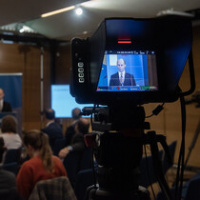Alain Peyraube tiszteleti tagi székfoglaló előadása angol nyelven
INAUGURAL ADDRESS
HUNGARIAN ACADEMY OF SCIENCES Section of Linguistics and Literary Scholarship requests your honourable presence at the
New horizons on the typology of East and Southeast Asian languages and more particularly of Sino-Tibetan and Sinitic languages
inaugural address of ALAIN PEYRAUBE honorary member of the Hungarian Academy of Sciences
Date and time: the 21st of November 2023, 2:00 p.m.
Venue: Library and Information Centre of the Hungarian Academy of Sciences Main Reading Room (1051 Budapest, Arany János u. 1, 1st floor)
A video and audio recording will be made of the performance, and your participation will also be part of the published recordings.
Linguists conventionally divide the 6,000-7,000 world languages – with almost half of them facing imminent extinction this century – into approximately 400-500 families, which differ greatly in size. For instance, the Austronesian family comprises over 1,200 languages, while some have merely one language, such as Basque, a well-known isolated linguistic form.
During the 20th century, comparisons among different language families was lacking, and the concept of macro-families was rarely suggested. Since the 1980s, this methodological gap has been corrected, thanks to scholars like Greenberg and his followers, who have revived earlier proposals, for example, Austric and Nostratic (renamed Eurasian) and introduced new macro-families such as Caucasian-Dene and Amerindian. These hypotheses are a topic of much debate within the linguistics community.
My presentation will examine the situation in East and Southeast Asia, outlining numerous potential grouping proposals and the challenge of presenting unequivocal arguments in favour of any particular one. This extensive geographical area is typically recognised to comprise five significant language families: Sino-Tibetan (categorised into two branches: the Sinitic and the Tibeto-Burman languages); Austronesian; Austro-Asiatic; Tai-Kadai; and Miao-Yao (Hmong-Mien).





